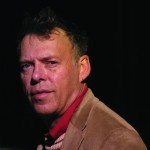
John Phillips
Londonprintstudio
john@londonprintstudio.org.uk
www.londonprintstudio.org.uk www.johnphillips.me.uk
Biography
John Phillips is an artist, photographer and printmaker and the Artistic Director of londonprintstudio (UK). He studied sculpture at Sheffield Polytechnic (now Sheffield Hallam University), and has a PhD in Fine Art from Brighton University. Following his undergraduate studies John arrived in West London in 1974, where he set up his own studio, which became Paddington Printshop, and arts resource that produced posters and prints, working with the extraordinary community that lived locally. He also teaches through the londonprintstudio’s MA programme.
Illustrated Talk
Tallinn, London, Tehran: Facilitating Intercultural Dialogue Through Print
Case studies of two separate print exhibitions are explored by the common UK partner (John Phillips, londonprintstudio ) and the international partners Eve Kask (Estonia) and Yashar Samimi (Iran). The presentation offers a unique opportunity to examine the potential for modestly resourced print collaborations to initiate and implement projects that facilitate cross-cultural exchange and understanding in the context of significant, and controversial, social and political contexts.
In 20011 londonprintstudio commissioned Memoirs from a Cold Utopia. Curated by Estonian artist Eve Kask, this exhibition, which initially contained work by eighteen Eastern European artists, marked the twentieth anniversary of the fall of the Soviet Union and explored ways in which artists had responded to social transformations in the region during the previous two decades. The exhibition was presented at londonprintstudio in 2011. It was subsequently enlarged and transferred to The Art Hall in Tallinn. Estonia.
In 2012 londonprintstudio created a small portfolio of digital works on the theme of London by seventeen UK artists. Entitled London Calling the portfolio was the first non-commercial visual arts event from the UK to be hosted in Iran for over twenty years. A second portfolio Tehran Calling London, which comprises work by twenty-two contemporary Iranian artists, was curated by Yashar Samimi and Tarlan Rafiee. Much of this work could not be shown openly in Iran.
The two portfolios were exhibited together at londonprintstudio in Spring 2013.
The illustrated talk will briefly outline the two exhibitions, their cultural contexts, similarities and differences alongside the exhibition strategies employed in the three cities. Most significantly it will provide the opportunity to explore these projects from the very different perspectives of the partners and seek to identify lessons that can be transferred to similar print-based projects in the future.
Exhibition
Paterei: Captive Light
Paterei an abandoned prison on the outskirts of Tallinn, Estonia. I photographed the site in 2011 and 2012. It is hard to identify the attraction. The building is in many parts dark, dirty and downright creepy. Even after standing in an unlit cell for a number of minutes, it is often difficult to take stock of what is there. Other parts are suffused with a quality of light that, when combined with the arched roof structures, evoke a church-like tranquillity and transcendence. With its empty, dank, multi-occupancy cells and execution chambers for the condemned, linked to lace-curtained officers’ quarters via a network of interlocked corridors, Paterei is the hollow corpse of a synthetic purgatory and hell. Setting up a camera in this space, and taking long exposures, led me, through a process analogous to the development of a darkroom print, to glimpse something not immediately evident to the eye; the architecture’s capacity to capture, channel and imprison light. Later, while sifting through these images the idea emerged of equivalence between this subject and the instrument employed to record it.
In other words, some of these images, for example a picture of tiny aperture illuminating a deep, low-vaulted room, seemed simultaneously to depict one of Paterei’s cells, and evoke the experience of standing inside the camera lens itself. In a number of photographs, the prison’s instruments of observation and control (bared and grated windows, spy holes and feeding flaps) channel shafts and pools of light to reveal the detritus and dramatic settings of inmate cells, warders rooms, and the ‘interior design’ of institutional oppression, and these images had, in turn, been ‘captured’ through an analogous technology comprising lens, shutter, and chamber.
This exhibition presents a selection of John Phillips’s photographs of Paterei Prison that are discussed in the academic paper Paterei: Captive Light.
